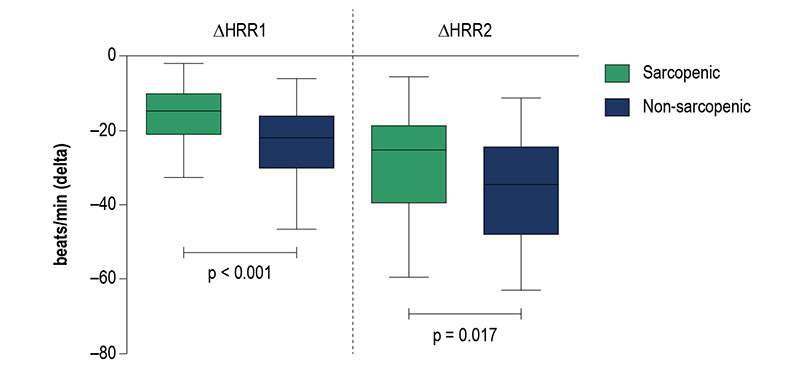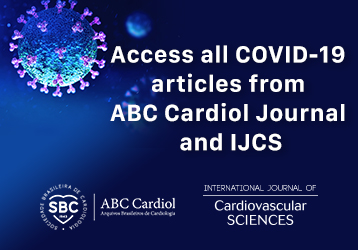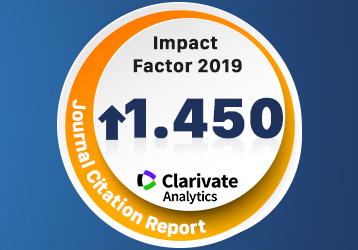Volume 112, Nº 6, June 2019
DOI: http://www.dx.doi.org/10.5935/abc.20190061
ORIGINAL ARTICLE
Sympatho-Vagal Imbalance is Associated with Sarcopenia in Male Patients with Heart Failure
Guilherme Wesley Peixoto da Fonseca
Marcelo Rodrigues dos Santos
Francis Ribeiro de Souza
Marcel Jose A. da Costa
Stephan von Haehling
Liliam Takayama
Rosa Maria R. Pereira
Carlos Eduardo Negrão
Stefan D. Anker
Maria Janieire de Nazaré Nunes Alves
Dra. Maria Janieire de Nazaré Nunes Alves e Dr. Guilherme Wesley Peixoto da Fonseca

Figure 2 – Delta heart rate recovery at 1st (ΔHRR1) and 2nd (ΔHRR2) minutes immediately after maximal exercise testing. Values are presented as medians with lower and upper quartiles (CI 95%). Note that sarcopenic patients showed a lower HRR at 1st (47% difference) and 2nd minutes (40% difference).
Abstract
Background: Resting sympathetic hyperactivity and impaired parasympathetic reactivation after exercise have been described in patients with heart failure (HF). However, the association of these autonomic changes in patients with HF and sarcopenia is unknown.
Objective: The aim of this study was to evaluate the impact of autonomic modulation on sarcopenia in male patients with HF. Methods: We enrolled 116 male patients with HF and left ventricular ejection fraction < 40%. All patients underwent a maximal cardiopulmonary exercise testing. Maximal heart rate was recorded and delta heart rate recovery (ΔHRR) was assessed at 1st and 2nd minutes after exercise. Muscle sympathetic nerve activity (MSNA) was recorded by microneurography. Dual‑energy X-ray absorptiometry was used to measure body composition and sarcopenia was defined by the sum of appendicular lean muscle mass (ALM) divided by height in meters squared and handgrip strength.
Results: Sarcopenia was identified in 33 patients (28%). Patients with sarcopenia had higher MSNA than those without (47 [41-52] vs. 40 [34‑48] bursts/min, p = 0.028). Sarcopenic patients showed lower ΔHRR at 1st (15 [10-21] vs. 22 [16‑30] beats/min, p < 0.001) and 2nd min (25 [19-39] vs. 35 [24-48] beats/min, p = 0.017) than non-sarcopenic. There was a positive correlation between ALM and ΔHRR at 1st (r = 0.26, p = 0.008) and 2nd min (r = 0.25, p = 0.012). We observed a negative correlation between ALM and MSNA (r = -0.29, p = 0.003).
Conclusion: Sympatho-vagal imbalance seems to be associated with sarcopenia in male patients with HF. These results highlight the importance of a therapeutic approach in patients with muscle wasting and increased peripheral sympathetic outflow. (Arq Bras Cardiol. 2019; 112(6):739-746)
Keywords: Heart Failure; Sarcopenia; Sympathetic Hyperactivity; Blunted Vagal Reactivation.















